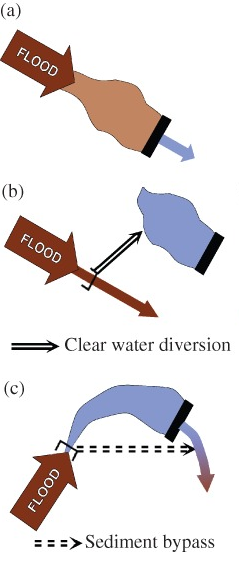Difference between revisions of "Off-channel reservoir storage"
Bendikhansen (talk | contribs) |
Bendikhansen (talk | contribs) m (Text replacement - "category:Measures" to "category:Solutions") |
||
| (2 intermediate revisions by the same user not shown) | |||
| Line 29: | Line 29: | ||
=Relevant literature= | =Relevant literature= | ||
| + | *Kondolf G.M., Gao Y., Annandale G.W., Morris G.L., Jiang E., Zhang J., Cao Y., Carling U.P., Fu K., Guo Q., Hotchkiss R., Peteuil C. , Sumi T., Wang H.‐W., Wang Z., Wei Z., Wu B., Wu C. and Yang C. T. 2014. Sustainable sediment management in reservoirs and regulated rivers: experiences from five continents. Earth's Future, 2 (2014), pp. 256-280 | ||
| + | *Morris, G. L., and Fan, J. 1998. Reservoir Sedimentation Handbook: Design and Management of Dams, Reservoirs and Watersheds for Sustainable Use, McGraw‐Hill Book Co., New York | ||
| − | [[category:Sediment measures]][[category: | + | [[category:Sediment measures]][[category:Solutions]] |
Latest revision as of 10:03, 26 October 2020
Contents
Introduction

Dams act as a barrier for sediment transport in river systems. Sediments-laden inflows bring sediments from upstream catchment that will be trapped when reaching the reservoir. Sediments deposit in the bottom of the reservoir and reduce its storage capacity. In geographical areas with very high sediment concentration, reservoirs can be filled after some years, rendering useless the infrastructure. Consequently, sediments are not transported downstream the dam, resulting in sediment starvation in the downstream river. Lack of sediments can induce severe morphological and ecological impacts.
Off-channel reservoirs, like sediment bypasses, are measures which aim at routing bed-load and part of the suspended sediment load through or around the reservoir (Morris et al. 1998, Kondolf et al. 2014). The objective is to maintain the storage capacity of the reservoir in addition to ensure sediment continuity in the river and avoid morphological and ecological impacts.
A diversion dam or weir is located in the river, allowing diverting of clear water to the reservoir at period of low flow and low sediment loads only, and leaving sediment-laden waters in the river.
Methods, tools, and devices
During planning
Similar to bypass tunnels, off-channel reservoir requires a sufficient gradient in the diversion tunnel to insure flow transport to the reservoir. The design of diversion tunnels to the off-channel reservoir depends on catchment characteristics like topography, geology, hydrology.
The advantage of off-channel reservoirs is that they prevent almost all bed load to enter the reservoir, and do not interfere with sediment continuity required to achieve good ecological status in rivers. However, the amount of water that can be diverted from the river and stored is limited to the flow capacity of the diversion channel. So, this measure is less suited to semi-arid and arid zones with short periods of very intense flows.
During implementation
Building of off-channel reservoirs have relatively high investments costs. They are part of the large structural measures to insure sediment continuity, requiring months to years for implementation.
During operation
Water discharge and sediment concentration in the river need to be permanently monitored so that clear water is diverted to the off-channel reservoir and sediment-laden waters flows through the river. The sediment concentration threshold for diverting or not waters to the reservoir will depend on the characteristics of the reservoir (shape, size) and the diversion structure, as well as the discharge.
Relevant MTDs and test cases
| Relevant MTDs | |
|---|---|
| BASEMENT | |
| Bedload monitoring system | |
| Relevant test cases | Applied in test case? |
| N/A | - |
Classification table
| Classification | Selection |
|---|---|
| Fish species for the measure | All |
| Does the measure require loss of power production | Operational (requires flow release outside turbine) |
| - | |
| - | |
| Recurrence of maintenance | Irregular at events |
| Which life-stage of fish is measure aimed at | Spawning / Recruitment |
| Juveniles | |
| Adult fish | |
| Movements of migration of fish | |
| Which physical parameter is addressed | - |
| - | |
| - | |
| Substrate and hyporheic zone | |
| - | |
| - | |
| - | |
| - | |
| Hydropower type the measure is suitable for | Plant in dam |
| Plant with bypass section | |
| Dam height (m) the measure is suitable for | Higher than 10 |
| Section in the regulated system measure is designed for | - |
| - | |
| Bypass section | |
| Downstream outlet | |
| River type implemented | Steep gradient (up to 0.4 %) |
| - | |
| - | |
| Level of certainty in effect | Moderately certain |
| Technology readiness level | TRL 9: actual system proven in operational environment |
| Cost of solution | See cost table |
Relevant literature
- Kondolf G.M., Gao Y., Annandale G.W., Morris G.L., Jiang E., Zhang J., Cao Y., Carling U.P., Fu K., Guo Q., Hotchkiss R., Peteuil C. , Sumi T., Wang H.‐W., Wang Z., Wei Z., Wu B., Wu C. and Yang C. T. 2014. Sustainable sediment management in reservoirs and regulated rivers: experiences from five continents. Earth's Future, 2 (2014), pp. 256-280
- Morris, G. L., and Fan, J. 1998. Reservoir Sedimentation Handbook: Design and Management of Dams, Reservoirs and Watersheds for Sustainable Use, McGraw‐Hill Book Co., New York